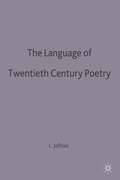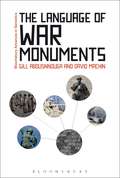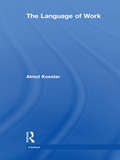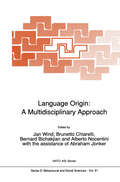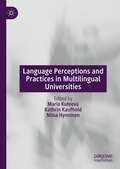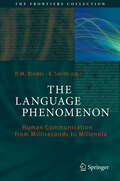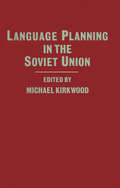- Table View
- List View
The Language of Twentieth Century Poetry
by Lesley HeffriesThis book draws on examples from throughout the twentieth century to illustrate the diversity of techniques used in this century's poetry. Organised according to linguistic themes, rather than chronologically, the chapters introduce the reader to the more subtle uses of sound, structure and meaning as well as illustrating well-known techniques handed-down from the poetic tradition. Examples are taken from the famous writers of the twentieth century, such as Yeats, Eliot and Plath and from less well-known poets. The book culminates in a chapter which draws together the linguistic themes into an integrated analysis of two rather different poems.
The Language of War Monuments (Bloomsbury Advances in Semiotics)
by David Machin Gill AbousnnougaThis book analyses war monuments by developing a multimodal social-semiotic approach to understand how they communicate as three-dimensional objects. The book provides a practical tool-kit approach to how critical multimodal social semiotics should be done through visual, textual and material analysis. It ties this material analysis into the social and political contexts of production. Using examples across the 20th and 21st century the book's chapters offer a way of analysing the way that monument designers have used specific semiotic choices in terms of things like iconography, objects, shape, form, angularity, height, materials and surface realisation to place representations of war in public places across Britain.This social-semiotic approach to the study of war monuments serves three innovative purposes. First, it provides a contribution to the work on the ideological representations of war in Media and Cultural Studies and in Critical Discourse Analysis applied specifically to more banal realisations of discourse. Second, it responds to calls by historians for innovative ways to study war commemoration by providing an approach that offers both specific analysis of the objects and attends to matters of design. Thirdly, following in the relatively recent tradition of multimodal analysis, the arguments draw on the ideas of Kress and van Leeuwen (1996, 2001), adapting and extending their theories and models to the analysis of British commemorative war monuments, in order to develop a multimodal framework for the analysis of three dimensional objects.
The Language of War Monuments (Bloomsbury Advances in Semiotics)
by David Machin Gill AbousnnougaThis book analyses war monuments by developing a multimodal social-semiotic approach to understand how they communicate as three-dimensional objects. The book provides a practical tool-kit approach to how critical multimodal social semiotics should be done through visual, textual and material analysis. It ties this material analysis into the social and political contexts of production. Using examples across the 20th and 21st century the book's chapters offer a way of analysing the way that monument designers have used specific semiotic choices in terms of things like iconography, objects, shape, form, angularity, height, materials and surface realisation to place representations of war in public places across Britain.This social-semiotic approach to the study of war monuments serves three innovative purposes. First, it provides a contribution to the work on the ideological representations of war in Media and Cultural Studies and in Critical Discourse Analysis applied specifically to more banal realisations of discourse. Second, it responds to calls by historians for innovative ways to study war commemoration by providing an approach that offers both specific analysis of the objects and attends to matters of design. Thirdly, following in the relatively recent tradition of multimodal analysis, the arguments draw on the ideas of Kress and van Leeuwen (1996, 2001), adapting and extending their theories and models to the analysis of British commemorative war monuments, in order to develop a multimodal framework for the analysis of three dimensional objects.
The Language of Wordsworth and Coleridge (The Language of Literature)
by Frances AustinIn this volume, Dr Frances Austin examines the language of William Wordsworth and Samuel Taylor Coleridge, both regarded as initiators of the Romantic movement in English Literature. She compares and contrasts the poetic language of the two poets, showing their interest in language and their deliberate break from the poetic diction of their predecessors, and the way in which that interest is transmuted into poetry.
The Language of Work
by Almut KoesterThe Intertext series has been specifically designed to meet the needs of contemporary English Language Studies. Working with Texts: A Core Introduction to Language Analysis (second edition 2001) is the foundation text, which is complemented by a range of 'satellite' titles. These provide students with hands-on practical experience of textual analysis through special topics, and can be used individually or in conjunction with Working with Texts. The Language of Work: examines how language is used in business and the workplace, looking at a range of situations and data: from meetings to informal negotiations, promotional letters to emails explores representations of work in advertising, career magazines and workplace talk looks at the way people in business interact through small talk, politeness, customer care and management-employee relationships is illustrated with lively examples taken from the real world and includes a full index of terms features a useful section on entering the world of work, exploring job adverts and texts that give advice on CV writing and developing 'transferable skills'.
The Language of Work
by Almut KoesterThe Intertext series has been specifically designed to meet the needs of contemporary English Language Studies. Working with Texts: A Core Introduction to Language Analysis (second edition 2001) is the foundation text, which is complemented by a range of 'satellite' titles. These provide students with hands-on practical experience of textual analysis through special topics, and can be used individually or in conjunction with Working with Texts. The Language of Work: examines how language is used in business and the workplace, looking at a range of situations and data: from meetings to informal negotiations, promotional letters to emails explores representations of work in advertising, career magazines and workplace talk looks at the way people in business interact through small talk, politeness, customer care and management-employee relationships is illustrated with lively examples taken from the real world and includes a full index of terms features a useful section on entering the world of work, exploring job adverts and texts that give advice on CV writing and developing 'transferable skills'.
Language Online: Investigating Digital Texts and Practices
by David Barton Carmen LeeIn Language Online, David Barton and Carmen Lee investigate the impact of the online world on the study of language. The effects of language use in the digital world can be seen in every aspect of language study, and new ways of researching the field are needed. In this book the authors look at language online from a variety of perspectives, providing a solid theoretical grounding, an outline of key concepts, and practical guidance on doing research. Chapters cover topical issues including the relation between online language and multilingualism, identity, education and multimodality, then conclude by looking at how to carry out research into online language use. Throughout the book many examples are given, from a variety of digital platforms, and a number of different languages, including Chinese and English. Written in a clear and accessible style, this is a vital read for anyone new to studying online language and an essential textbook for undergraduates and postgraduates working in the areas of new media, literacy and multimodality within language and linguistics courses.
Language Online: Investigating Digital Texts and Practices
by David Barton Carmen LeeIn Language Online, David Barton and Carmen Lee investigate the impact of the online world on the study of language. The effects of language use in the digital world can be seen in every aspect of language study, and new ways of researching the field are needed. In this book the authors look at language online from a variety of perspectives, providing a solid theoretical grounding, an outline of key concepts, and practical guidance on doing research. Chapters cover topical issues including the relation between online language and multilingualism, identity, education and multimodality, then conclude by looking at how to carry out research into online language use. Throughout the book many examples are given, from a variety of digital platforms, and a number of different languages, including Chinese and English. Written in a clear and accessible style, this is a vital read for anyone new to studying online language and an essential textbook for undergraduates and postgraduates working in the areas of new media, literacy and multimodality within language and linguistics courses.
Language or Dialect?: The History of a Conceptual Pair
by Raf Van RooyThis book provides a historiographic study of the distinction between language and dialect, a puzzle which has long fascinated linguists and laypeople alike. It offers a comprehensive account of the intriguing and complex history of the language-dialect pair, and shows that its real origins can be found in sixteenth-century humanist scholarship. The book begins with a survey of the prehistory of the language/dialect distinction in antiquity and the Middle Ages. Raf Van Rooy then provides a detailed investigation of the emergence, establishment, and development of the conceptual pair during the early modern period, from the Renaissance to the Enlightenment, when linguistic diversity was first studied in depth. Finally, the much-debated and ambiguous fate of the language/dialect opposition in modern linguistics is explored: although a number of earlier ideas were adopted by later scholars, many linguists today question the notion of a seemingly arbitrary and subjective distinction between language and dialect.
Language Origin: A Multidisciplinary Approach (NATO Science Series D: #61)
by AbrahamJonker AlbertoNocentini BernardBichakjian BrunettoChiarelli JanWindLanguage Origin: A Multidisciplinary Approach presents a synthesis of viewpoints and data on linguistic, psychological, anatomical and behavioral studies on living species of Primates and provides a comparative framework for the evaluation of paleoanthropological studies. This double endeavor makes it possible to direct new research on the nature and evolution of human language and cognition. The book is directed to students of linguistics, biology, anthropoloy, anatomy, physiology, neurology, psychology, archeology, paleontology, and other related fields. A better understanding of speech pathology may stem from a better understanding of the relationship of human communication to the evolution of our species. The book is conceived as a timely contribution to such knowledge since it allows, for the first time, a systematic assessment of the origins of human language from a comprehensive array of scientific viewpoints.
Language Pangs: On Pain and the Origin of Language
by Ilit FerberWe usually think about language and pain as opposites, the one being about expression and connection, the other destructive, "beyond words" so to speak, and isolating. Language Pangs challenges these familiar conceptions and offers a radical reconsideration of the relationship between pain and language in terms of an essential interconnectedness. Ilit Ferber's premise is that we cannot probe the experience of pain without taking account its inherent relation to language; and vice versa, that our understanding of the nature of language essentially depends on how we take account of its correspondence with pain. Language Pangs brings together discussions of philosophical as well as literary texts, an intersection that is especially productive in considering the phenomenology of pain and its bearing on language. Ferber explores a phenomenology of pain and its relation to language, before providing a unique close reading of Johann Gottfried Herder's Treatise on the Origin of Language, the first modern philosophical text to consider language and pain, establishing the cry of pain as the origin of language. Herder also raises important claims regarding the relationship between human and animal, questions of sympathy and the role of hearing in the expression of pain. Beyond Herder, the book grapples with the work of other profound thinkers, including Martin Heidegger, Stanley Cavell, and André Gide, and finally, Sophocles, from them weaving new insights on the experience of pain, expression, sympathy, and hearing.
Language Pangs: On Pain and the Origin of Language
by Ilit FerberWe usually think about language and pain as opposites, the one being about expression and connection, the other destructive, "beyond words" so to speak, and isolating. Language Pangs challenges these familiar conceptions and offers a radical reconsideration of the relationship between pain and language in terms of an essential interconnectedness. Ilit Ferber's premise is that we cannot probe the experience of pain without taking account its inherent relation to language; and vice versa, that our understanding of the nature of language essentially depends on how we take account of its correspondence with pain. Language Pangs brings together discussions of philosophical as well as literary texts, an intersection that is especially productive in considering the phenomenology of pain and its bearing on language. Ferber explores a phenomenology of pain and its relation to language, before providing a unique close reading of Johann Gottfried Herder's Treatise on the Origin of Language, the first modern philosophical text to consider language and pain, establishing the cry of pain as the origin of language. Herder also raises important claims regarding the relationship between human and animal, questions of sympathy and the role of hearing in the expression of pain. Beyond Herder, the book grapples with the work of other profound thinkers, including Martin Heidegger, Stanley Cavell, and André Gide, and finally, Sophocles, from them weaving new insights on the experience of pain, expression, sympathy, and hearing.
Language Perceptions and Practices in Multilingual Universities
by Maria Kuteeva Kathrin Kaufhold Niina HynninenThis edited book examines language perceptions and practices in multilingual university contexts in the aftermath of recent theoretical developments questioning the conceptualization of language as a static entity, drawing on case studies from different Northern European contexts in order to explore the effects of phenomena including internationalization, widening participation, and migration patterns on language attitudes and ideologies. The book provides cutting-edge perspectives on language uses in Northern European universities by drawing attention to the multiplicity of language practices alongside the prominence of English in international study programmes and research publication. It will be of interest to students and scholars of multilingualism, sociolinguistics, applied linguistics, and education, as well as language policymakers. bfiqo
The Language Phenomenon: Human Communication from Milliseconds to Millennia (The Frontiers Collection)
by P.-M. Binder and K. SmithThis volume contains a contemporary, integrated description of the processes of language. These range from fast scales (fractions of a second) to slow ones (over a million years). The contributors, all experts in their fields, address language in the brain, production of sentences and dialogues, language learning, transmission and evolutionary processes that happen over centuries or millenia, the relation between language and genes, the origins of language, self-organization, and language competition and death. The book as a whole will help to show how processes at different scales affect each other, thus presenting language as a dynamic, complex and profoundly human phenomenon.
Language Planning and Microlinguistics: From Policy to Interaction and Vice Versa
by Winifred V. Davies Evelyn ZieglerWhilst earlier studies of language planning and of standardisation have tended to study macro processes, this volume is in line with more recent work aimed at bridging the macro and the micro levels by examining how the two interact and influence each other. It covers seven countries and deals with a range of sociolinguistic constellations.
Language Planning and National Identity in Croatia (Palgrave Studies in Minority Languages and Communities)
by K. Langston A. Peti-StanticFollowing the collapse of the former Yugoslavia, Croatian was declared to be a separate language, distinct from Serbian, and linguistic issues became highly politicized. This book examines the changing status and norms of the Croatian language and its relationship to Croatian national identity, focusing on the period after Croatian independence.
Language Planning as a Sociolinguistic Experiment: The Case of Modern Norwegian (PDF)
by Ernst Håkon Jahr2014 marks the 200th anniversary of the birth of the Norwegian nation following centuries of Danish rule. This book analyses how Norwegians defined, fought over, and developed their own independent Scandinavian language, differentiating it from Danish and Swedish, through language planning.
Language Planning in the Post-Communist Era: The Struggles For Language Control In The New Order In Eastern Europe, Eurasia And China
by Ernest AndrewsThis volume provides an in-depth analysis of the attempts of language experts and governments to control language use and development in Eastern Europe, Eurasia and China through planned activities generally known as language planning or language policy. The ten case studies presented here examine language planning in China, Russia, Tatarstan, Central Asia, Ukraine, Lithuania, Latvia, Poland, Slovakia and the Czech Republic, and focus in particular on developments and disputes that have occurred since the ‘fall of communism’ and the emergence of a new order in the late 1980s. Its authors highlight the dominant issues with which language planning is invariably intertwined. These include power politics, tensions between ‘official language’ and ‘minority languages’, and the effects of a country’s particular political, social, cultural and psychological environment. Offering a detailed account of the socio-political and ideological developments that underlie language planning in these regions, this book will provide a valuable resource for students and scholars of linguistics, cultural studies, political science, sociology and history.
Language Planning in the Post-Communist Era: The Struggles for Language Control in the New Order in Eastern Europe, Eurasia and China
by Ernest AndrewsThis volume provides an in-depth analysis of the attempts of language experts and governments to control language use and development in Eastern Europe, Eurasia and China through planned activities generally known as language planning or language policy. The ten case studies presented here examine language planning in China, Russia, Tatarstan, Central Asia, Ukraine, Lithuania, Latvia, Poland, Slovakia and the Czech Republic, and focus in particular on developments and disputes that have occurred since the ‘fall of communism’ and the emergence of a new order in the late 1980s. Its authors highlight the dominant issues with which language planning is invariably intertwined. These include power politics, tensions between ‘official language’ and ‘minority languages’, and the effects of a country’s particular political, social, cultural and psychological environment. Offering a detailed account of the socio-political and ideological developments that underlie language planning in these regions, this book will provide a valuable resource for students and scholars of linguistics, cultural studies, political science, sociology and history.
Language Play
by David CrystalIn this exhilarating and often hilarious book, David Crystal examines why we devote so much time and energy to language games, how professionals make a career of them, and how young children instinctively take to them. Crystal makes a simple argument-that since playing with language is so natural, a natural way to learn language is to play with it-while he discusses puns, crosswords, lipograms, comic alphabets, rhymes, funny voices taken from dialect and popular culture, limericks, anagrams, scat singing, and much more.
Language Poets Use
by Winifred NowottnyMrs Nowottny's chief aim in this 'valuable book which could serve as a useful introduction to practical criticism' is to inquire what it is that makes the language of poetry poetic. The book grows out of the leading trends today in ideas about language and the way is works but to the maters discussed Mrs. Nowottny brings a keen mind of her won and considerable powers as a literary critic. Stressing the continuity of poetry with other uses of language she shows how under the control of the poet's purpose everyday language contributes to the achievement of the most complex and profound effects, and she illustrates these effects with a wealth of examples.
Language Policies and the Politics of Language Practices: Essays in Honour of Sjaak Kroon (Language Policy #28)
by Massimiliano Spotti Jos Swanenberg Jan BlommaertThis edited volume consists of chapters celebrating the career of scholar Sjaak Kroon, who has produced ground-breaking work in the field of ethnography of education, immigrant minority language teaching and language politics. The chapters cover the use of immigrant minority languages in education and the development of policies at all levels and across the globe in this sometimes over-policed field. It particularly focuses on language policy analysis in which both the top-down institutional and the bottom-up ethnographic dimensions are blended, and in which globalization is the main macro-perspective. The chapters describe sensitive tools for investigating, unravelling and understanding the grey space connecting formal language policies to informal politics and practices of language on the ground.
Language Policy: A Practical Guide (Research and Practice in Applied Linguistics #7)
by D. JohnsonA detailed overview of the theories, concepts, research methods, and findings in the field of language policy is provided here in one accessible source. The author proposes new methodological, theoretical, and conceptual directions and offers guidance for doing language policy research.
Language Policy: Hidden Agendas and New Approaches
by Elana ShohamyPolicies concerning language use are increasingly tested in an age of frequent migration and cultural synthesis. With conflicting factors and changing political climates influencing the policy-makers, Elana Shohamy considers the effects that these policies have on the real people involved. Using examples from the US and UK, she shows how language policies are promoted and imposed, overtly and covertly, across different countries and in different contexts. Concluding with arguments for a more democratic and open approach to language policy and planning, the final note is one of optimism, suggesting strategies for resistance to language attrition and ways to protect the linguistic rights of groups and individuals.
